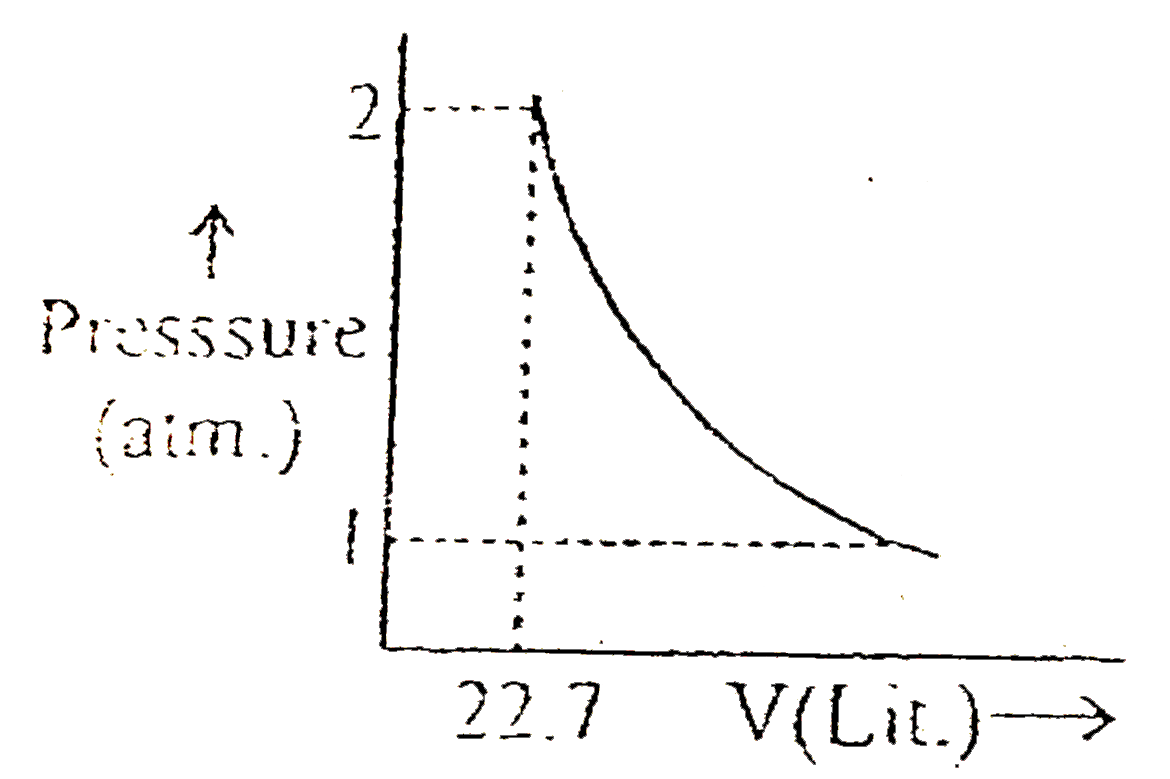One mole of an ideal gas is allowed to expand reversible and adiabatically from a temperatureof27∘C)if the work done during the process is3kJ,the final temperature will be equal to(Cv=20JK−1)
The correct Answer is:A, B, C
To solve the problem, we will follow these steps:
Step 1: Understand the Given Information
We have:
- Number of moles (n) = 1 mole
- Initial temperature (T1) = 27°C = 300 K (converted to Kelvin)
- Work done (W) = -3 kJ = -3000 J (since work done during expansion is negative)
- Heat capacity at constant volume (Cv) = 20 J/K
Step 2: Apply the First Law of Thermodynamics
The first law of thermodynamics states:
ΔU=Q+W
In an adiabatic process, Q=0. Therefore:
ΔU=W
Since the work done is negative (because the gas is expanding), we can write:
ΔU=−W=3000 J
Step 3: Relate Change in Internal Energy to Temperature Change
The change in internal energy (ΔU) for an ideal gas can also be expressed as:
ΔU=nCvΔT
where ΔT=T2−T1. Substituting the known values:
3000=1×20×(T2−300)
Step 4: Solve for the Final Temperature T2
Rearranging the equation:
3000=20(T2−300)
Dividing both sides by 20:
150=T2−300
Now, solving for T2:
T2=150+300=450 K
Step 5: Convert the Final Temperature to Celsius (if needed)
If required, we can convert the final temperature back to Celsius:
T2=450−273=177°C
Final Answer
The final temperature T2 after the adiabatic expansion is 450 K or 177°C.
---
We have:
- Number of moles (n) = 1 mole
- Initial temperature (T1) = 27°C = 300 K (converted to Kelvin)
- Work done (W) = -3 kJ = -3000 J (since work done during expansion is negative)
- Heat capacity at constant volume (Cv) = 20 J/K
The first law of thermodynamics states:
ΔU=Q+W
In an adiabatic process, Q=0. Therefore:
ΔU=W
Since the work done is negative (because the gas is expanding), we can write:
ΔU=−W=3000 J
The change in internal energy (ΔU) for an ideal gas can also be expressed as:
ΔU=nCvΔT
where ΔT=T2−T1. Substituting the known values:
3000=1×20×(T2−300)
Rearranging the equation:
3000=20(T2−300)
Dividing both sides by 20:
150=T2−300
Now, solving for T2:
T2=150+300=450 K
If required, we can convert the final temperature back to Celsius:
T2=450−273=177°C
The final temperature T2 after the adiabatic expansion is 450 K or 177°C.
Topper's Solved these Questions
Similar Questions
One mole of an ideal monoatomic gas expands reversibly and adiabatically from a volume of x litre to 14 litre at 27∘C. Then value of x will be [Given, final temperature 189 K and CV = 3/2 R].
View Solution2 mole of an ideal gas at 27∘C expands isothermally and reversibly from a volume of 4 litre to 40 litre. The work done (in kJ) by the gas is :
View Solution2 mol of an ideal gas at 27∘C expand isothermally and reversibly
from a volume of 2L to 20L. The work done (in KJ) by the gas is :-
View Solution5mol of an ideal gas at 27∘C expands isothermally and reversibly from a volume of 6L to 60L. The work done in kJ is
View Solution5mol of an ideal gas at 27∘C expands isothermally and reversibly from a volume of 6L to 60L. The work done in kJ is
View SolutionFive moles of an ideal gas undergoes reversible expansion from 1 L to 4 L at 27oC. The work done and enthalpy change for the process respectively are
View SolutionOne mole of an ideal and monoatomic gas is expanded reversibly and isothermally at 298K temperature according to the given diagram, calculate work done.

View Solution5 mol of an ideal gas expand reversibly from a volume of 8dm3 to 80dm3 at an temperature of 27∘C. Calculate the change in entropy.
View Solution5mol of an ideal gas expands reversibly from a volume of 8dm3 to 80dm3 at a temperature of 27∘C. Calculate the chngae in entropy.
View SolutionIf x mole of ideal gas at 27∘C expands isothermally and reversibly from a volume of y to 10 y, then the work done is
View Solution

